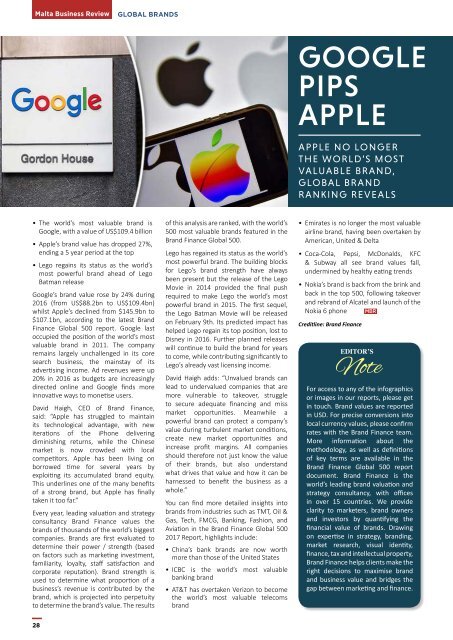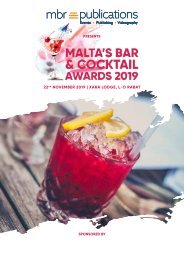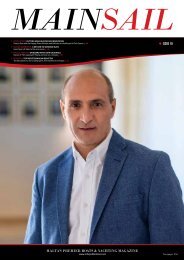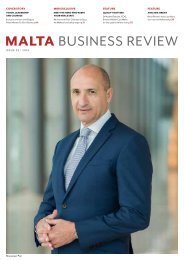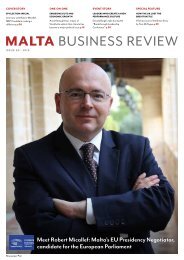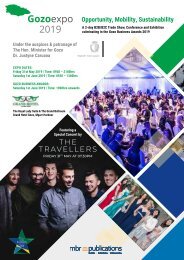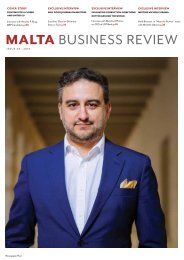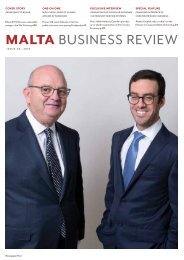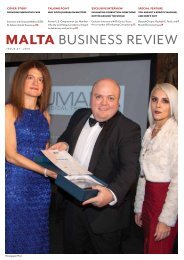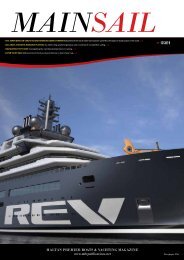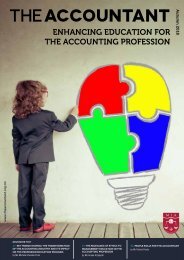MBR_Issue_28 -February 2017
Create successful ePaper yourself
Turn your PDF publications into a flip-book with our unique Google optimized e-Paper software.
Malta Business Review<br />
GLOBAL BRANDS<br />
<strong>MBR</strong> EU & GLOBAL NEWS ROUND-UP<br />
Malta Business Review<br />
• The world’s most valuable brand is<br />
Google, with a value of US$109.4 billion<br />
• Apple’s brand value has dropped 27%,<br />
ending a 5 year period at the top<br />
• Lego regains its status as the world’s<br />
most powerful brand ahead of Lego<br />
Batman release<br />
Google’s brand value rose by 24% during<br />
2016 (from US$88.2bn to US$109.4bn)<br />
whilst Apple’s declined from $145.9bn to<br />
$107.1bn, according to the latest Brand<br />
Finance Global 500 report. Google last<br />
occupied the position of the world’s most<br />
valuable brand in 2011. The company<br />
remains largely unchallenged in its core<br />
search business, the mainstay of its<br />
advertising income. Ad revenues were up<br />
20% in 2016 as budgets are increasingly<br />
directed online and Google finds more<br />
innovative ways to monetise users.<br />
David Haigh, CEO of Brand Finance,<br />
said: “Apple has struggled to maintain<br />
its technological advantage, with new<br />
iterations of the iPhone delivering<br />
diminishing returns, while the Chinese<br />
market is now crowded with local<br />
competitors. Apple has been living on<br />
borrowed time for several years by<br />
exploiting its accumulated brand equity.<br />
This underlines one of the many benefits<br />
of a strong brand, but Apple has finally<br />
taken it too far.”<br />
Every year, leading valuation and strategy<br />
consultancy Brand Finance values the<br />
brands of thousands of the world’s biggest<br />
companies. Brands are first evaluated to<br />
determine their power / strength (based<br />
on factors such as marketing investment,<br />
familiarity, loyalty, staff satisfaction and<br />
corporate reputation). Brand strength is<br />
used to determine what proportion of a<br />
business’s revenue is contributed by the<br />
brand, which is projected into perpetuity<br />
to determine the brand’s value. The results<br />
of this analysis are ranked, with the world’s<br />
500 most valuable brands featured in the<br />
Brand Finance Global 500.<br />
Lego has regained its status as the world’s<br />
most powerful brand. The building blocks<br />
for Lego’s brand strength have always<br />
been present but the release of the Lego<br />
Movie in 2014 provided the final push<br />
required to make Lego the world’s most<br />
powerful brand in 2015. The first sequel,<br />
the Lego Batman Movie will be released<br />
on <strong>February</strong> 9th. Its predicted impact has<br />
helped Lego regain its top position, lost to<br />
Disney in 2016. Further planned releases<br />
will continue to build the brand for years<br />
to come, while contributing significantly to<br />
Lego’s already vast licensing income.<br />
David Haigh adds: “Unvalued brands can<br />
lead to undervalued companies that are<br />
more vulnerable to takeover, struggle<br />
to secure adequate financing and miss<br />
market opportunities. Meanwhile a<br />
powerful brand can protect a company’s<br />
value during turbulent market conditions,<br />
create new market opportunities and<br />
increase profit margins. All companies<br />
should therefore not just know the value<br />
of their brands, but also understand<br />
what drives that value and how it can be<br />
harnessed to benefit the business as a<br />
whole.”<br />
You can find more detailed insights into<br />
brands from industries such as TMT, Oil &<br />
Gas, Tech, FMCG, Banking, Fashion, and<br />
Aviation in the Brand Finance Global 500<br />
<strong>2017</strong> Report, highlights include:<br />
• China’s bank brands are now worth<br />
more than those of the United States<br />
• ICBC is the world’s most valuable<br />
banking brand<br />
• AT&T has overtaken Verizon to become<br />
the world’s most valuable telecoms<br />
brand<br />
GOOGLE<br />
PIPS<br />
APPLE<br />
APPLE NO LONGER<br />
THE WORLD’S MOST<br />
VALUABLE BRAND,<br />
GLOBAL BRAND<br />
RANKING REVEALS<br />
• Emirates is no longer the most valuable<br />
airline brand, having been overtaken by<br />
American, United & Delta<br />
• Coca-Cola, Pepsi, McDonalds, KFC<br />
& Subway all see brand values fall,<br />
undermined by healthy eating trends<br />
• Nokia’s brand is back from the brink and<br />
back in the top 500, following takeover<br />
and rebrand of Alcatel and launch of the<br />
Nokia 6 phone <strong>MBR</strong><br />
Creditline: Brand Finance<br />
EDITOR’S<br />
Note<br />
For access to any of the infographics<br />
or images in our reports, please get<br />
in touch. Brand values are reported<br />
in USD. For precise conversions into<br />
local currency values, please confirm<br />
rates with the Brand Finance team.<br />
More information about the<br />
methodology, as well as definitions<br />
of key terms are available in the<br />
Brand Finance Global 500 report<br />
document. Brand Finance is the<br />
world’s leading brand valuation and<br />
strategy consultancy, with offices<br />
in over 15 countries. We provide<br />
clarity to marketers, brand owners<br />
and investors by quantifying the<br />
financial value of brands. Drawing<br />
on expertise in strategy, branding,<br />
market research, visual identity,<br />
finance, tax and intellectual property,<br />
Brand Finance helps clients make the<br />
right decisions to maximise brand<br />
and business value and bridges the<br />
gap between marketing and finance.<br />
Organisations need to have a mechanism<br />
for managing risk. This may be through a risk<br />
management group, or a sub-committee<br />
of the executive or board of directors.<br />
There are also many different mechanisms<br />
for managing risk. This might include the<br />
following steps:<br />
• Promote risk awareness in the business.<br />
It is fundamental that everyone in the<br />
organisation, and not just those that sit<br />
on the board or are members of the risk<br />
management group, can recognise the<br />
importance of identifying risks and take<br />
ownership for minimising the exposure<br />
to those risks.<br />
• Identify possible causes and<br />
consequences of hazards in the<br />
organisation. Consistent separation of<br />
causes and consequences simplifies<br />
risk analysis and facilitates efficient risk<br />
handling.<br />
• Assess and evaluate the risks. The<br />
probability of the identified causes<br />
is assessed in terms such as ‘often’,<br />
‘frequent’, ‘sometimes’, etc. The<br />
severity of the identified consequences<br />
is assessed or similarly expressed in<br />
such terms as ‘catastrophic’, ‘critical’,<br />
‘small’, etc. This will also identify those<br />
risks that require action i.e. starting with<br />
The Importance of Organisational Risk Management<br />
By Deborah Schembri, Managing Director, STM Malta Trust & Company Management Ltd<br />
those with highest probability and most<br />
severe impact.<br />
• Take action on the risks identified as<br />
priority. A systematic approach needs<br />
to be adopted which allows risks to be<br />
handled consistently according to their<br />
causes and consequences.<br />
• Cause-related handling uses<br />
measures that avoid or reduce risks<br />
by diminishing the probability of<br />
their occurring.<br />
• Consequence-related handling uses<br />
measures that are productive after<br />
a problem has occurred.<br />
• Integrate the process within the<br />
organisation. This involves periodically<br />
repeating the above four steps. It<br />
is important to have a feedback<br />
mechanism and central to this is the<br />
flow of information from the risk<br />
management process. All information<br />
must be centrally gathered, analysed<br />
and fed back to the business. Risk<br />
management should become second<br />
nature to the senior team and the<br />
workforce. <strong>MBR</strong><br />
EDITOR’S<br />
Note<br />
Deborah Schembri<br />
BA(Hons) Accty.,<br />
Dip. Tax., FIA, CPA,<br />
DipPMI, MIM, MBA<br />
(Henley) has 20 years’ experience in the<br />
financial services, gaming and hospitality<br />
industries. In her various C-level and board<br />
member roles she had formulated new<br />
strategic directions and implemented the<br />
necessary changes. She has been instrumental<br />
in setting up and growing various companies.<br />
She is a Certified Public Accountant, holds a<br />
Master’s in Business Administration from<br />
Henley Management College and holds a<br />
Diploma in Retirement Provision pursued<br />
with the UK Pensions Management Institute.<br />
She is the only Maltese resident holding<br />
such a qualification in pensions. Deborah<br />
won Malta’s Best Knowledge Entrepreneur<br />
of the Year Award 2015. She has also been<br />
nominated and then voted as one of the four<br />
finalists for the Commonwealth Women<br />
Entrepreneur of the Year 2015.<br />
<strong>28</strong> 29<br />
www.maltabusinessreview.net


